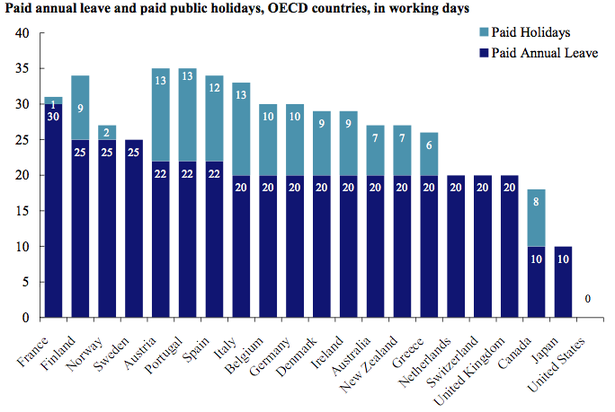By Derek Thompson
The United States has no vacation policy — and neither do families, judging from surveys of workers’ time off. Are we doing it wrong? Tell us how you use breaks and vacations to manage your productivity, and we’ll publish your best responses later this week.

If something must exist for it to be broken, then U.S. national vacation policy cannot be broken, because there isn’t one. Here’s a graph of federal paid annual leave policies across advanced economies in the OECD. Look to the far right. See us? We’re the one at zero.

So, America is exceptional. But not wiser, perhaps. The science of productivity is pretty clear that anything from a coffee break to a two-week vacation can make us better workers by replenishing our energy and attention and allowing our brains to make new connections that are obscured in the daily grind. Even at companies that offer vacation time (the vast majority of them), Americans often don’t take advantage. We like working, or at least we’re so afraid of not working that we deny ourselves breaks that might, paradoxically, make us more productive in the long term. Are we crazy?
Since it’s August, and you’re either on vacation yourself or barely working at your desk, I wanted to turn the question over to you. Instead of focusing on the national level, l want to hear from your personal experience. What kind of vacation and time-off policy does your company offer, and — most importantly — do you agree with it? Or do you think there would be a smarter way for companies and employees to work together to create a schedule and vacation policy that maximized both our happiness and even our effectiveness?
***
When are you at your most productive? If you’re like me, you ask yourself that question all the time. And 95 years ago, Dr. A. F. S. Kent tried to answer it by studying factory workers by day of the week. He determined that people worked least effectively on Mondays and best on Saturdays (this was before two-day weekends were national). This conclusion has been duplicated again, and again — well, at least half of it. The Monday blues are a real thing, studies have repeatedly shown. But most workers really start firing on all cylinders some time toward the middle/end of the week before they occasionally flag on Friday.
From this research, productivity gurus have gleaned at least three variables that are crucial to determining your output. The first is practice efficiency. Like computers, we need time to boot up, and it’s only after a bit of practice that we “hit our groove.” That’s one reason Monday’s feel slow. We’re still trying to find our flow. The second is energy. Simply: Our bodies get tired, and it’s as true for our brains as our other muscles. You don’t manufacture attention so much as consume it from a finite supply. When the supply runs out — around 9pm on a Wednesday (or, uh, 3pm on a Friday?) — productivity falls. The third is end spurt. We don’t just work better near deadlines. We also work harder near finish lines. Ever feel inspired by Thursday’s proximity to the weekend that you work a little bit harder? That’s the end spurt talkin’.
So the issue for me, as I think about answering the question I posed above, is what kind of schedule maximizes practice efficiency, energy, and end spurts? It would seem to be one where breaks were short enough that workflow and neural connectivity didn’t atrophy too much; where I rarely worked myself to exhaustion; and where breaks were rewarding and alluring, so as to create a sense of an end line. My sense is that this would strengthen the case for flex-time to allow people to work more half-days, even on the weekends, which would give them time off to spend with their family and rest their brains without arresting their workflow. Anyway, that’s my thought. I’m much more interested to hear yours.
